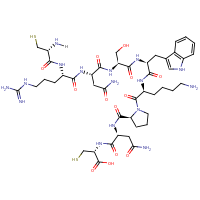-
Interaction
| AccNo. |
21941 |
Score |
0.86 |
| Name |
CRNSW_heart |
Environment |
in vivo |
| Kd |
1.0 |
Organism |
Mus musculus (Mouse) |
|
Peptide
| AccNo. |
21825 |
| Name |
CRNSW |
| Organism |
N/A |
| Constraint |
disulfide |
| Sequence |
CRNSWKPNC

|
| Origin |
phage display |
| Form |
phage |
| Internalized |
no |
| Unnatural |
no |
| Imaging |
no |
| Is Motif |
no |
|
Interactor
| AccNo. |
21672 |
| Name |
heart |
| Description |
heart vasculature |
| Organism |
Mus musculus (Mouse) |
| Type |
tissue |
|
Experiment
| AccNo. |
21878 |
Classification incorrect?
Click the corresponding button to vote. Your vote
is used to improve the automatic classification.

|
| CA |
CVD |
DM |
APO |
ANG |
MI |
BD |
|
| 1.00 |
1.00 |
1.00 |
0.50 |
0.61 |
1.00 |
0.75 |
Vote |
 |
 |
 |
 |
 |
 |
 |
Yes |
 |
 |
 |
 |
 |
 |
 |
No |
|
| Name |
PD_12 |
| Detection |
affinity technology, MI:0400 |
| Source |
PDF |
Text Id |
12 |
| Journal |
Circulation. 2005 Sep 13;112(11):1601-11. Epub 2005 Sep 06. |
| Title |
Molecular profiling of heart endothelial cells. |
| Authors |
Zhang L, Hoffman JA, Ruoslahti E |
| Text |
BACKGROUND: Endothelial cells that line the vascular lumen can express cell-surface proteins that are specific to the endothelium of a particular tissue. In this study, we probed the heart vasculature for heart-specific endothelial markers by phage display. METHODS AND RESULTS: We used a novel combination of in vivo phage selection and a bacterial 2-hybridization scheme against a heart cDNA library, which allows simultaneous identification of peptides that specifically bind to the target endothelium, as well as the endothelial molecules (receptors) recognized by the peptides. We found 5 heart-targeting peptides and their receptors. We confirmed and quantified the selective expression of 4 of the proteins in heart endothelial cells by independent methods. The heart specificity of phages was as high as 300-fold greater than that of nonrecombinant control phages. The proteins selectively expressed by the heart endothelium were in most cases also expressed by cardiomyocytes and, at lower levels, in some other tissues. CONCLUSIONS: These findings provide new markers for the endothelium of heart vessels and reveal a commonality between parenchymal and endothelial gene expression in the heart. The heart-homing peptides provide a means of targeting diagnostic and therapeutic agents to the heart, and their receptors are potential drug discovery targets. |
| Mesh Terms |
Animals; Bacteriophages; Biological Markers/metabolism; Carrier Proteins/metabolism; Cells, Cultured; Coronary Vessels/cytology; Coronary Vessels/metabolism; Endothelial Cells/metabolism; Female; Injections, Intravenous; Ligands; Male; Mice; Mice, Inbred Strains; Myocardium/metabolism; Oligopeptides/administration & dosage; Oligopeptides/pharmacokinetics; Peptide Library; Peptides/metabolism; RNA, Messenger/metabolism; Receptors, Cell Surface/genetics; Receptors, Cell Surface/metabolism; Tissue Distribution; Two-Hybrid System Techniques |
References
|